|
This page describes the solar photovoltaic work done on my house. I mention the choices I made and evaluate performance. |

|
This page describes the solar photovoltaic work done on my house. I mention the choices I made and evaluate performance. |

|
When Norma and I first saw our future house in Savage, Maryland, one of the first things we noticed was the south-facing garage roof which was unobstructed by trees. "Wouldn't that be a nice place to put solar panels?"
About seven months after purchasing the house, I started looking into this more seriously. At a local environmental meeting, I met someone from my old gym who owned his own solar company. He gave me his card. I also spoke to our neighbors, Don and Sara, who showed me the photovoltaic (PV) panels and microinverters they had installed. "Photovoltaic" means the panels are used to generate electricity, as compared to "thermal" which is used to generate heat. They recommended a couple of companies to me. I also got a recommendation for a roofer from Ralph. I now had enough information to get started and the motivation to get the ball rolling. In our first year, we used about 9,716 kilowatt hours (810 per month, 26.6 per day). It was estimated that high efficiency solar panels covering the south side of the garage could reduce our electricity consumption by 48%! Based on electricity costing $0.119 per kilowatt hour in November 2010, solar panels should reduce our electric bill by $568 per year. Note that we have oil heat and use electricity for our water heater, stove, and oven. We have no gas line running to the house.  |

|
When it comes to making a big purchase, I almost never check with just one company. So I interviewed salespeople from three companies. I also tried to contact a fourth but they were too slow to respond. Of the three, I went with Solar Energy World.
Having the right salesperson really makes a big difference. At Solar Energy World, I was first contacted by Geoff Mirkin, the vice president. Then I spoke to Brent Cotton, a man who could sell freezers to Inuits. Of the three salespersons I spoke to, all were friendly, professional, and knowledgeable. But Brent was best able to communicate his knowledge. Maybe it is because he has an engineering background and I have a math background. I almost felt like his talent was being wasted talking to just me...he should have been lecturing to a few hundred people in an auditorium. But still, I am not one to just let a good salesperson sway me. I followed up with what he said, doing a little background checking on my own. The other companies wanted to sell me microinverters. I heard and read good things about microinverters. But Brent was the only one who told me I didn't need them. When a salesman tries to SAVE me money, my ears perk up. I spent a good deal of time investigating why microinverters are needed. For many situations, they are good...particularly in less than ideal situation, like when some panels get shade while others get sun. But my situation was a little different. The south side of my garage roof had no nearby trees to provide shade. The panels would be 20 degrees off due south according to Google Maps (azimuth 160 degree) and the solar access would be 98%. Additionally, if I went with Brent's suggestions, I would be buying the SunPower 230 monocrystalline photovoltaic solar panels. With 18.5% efficiency, these are the Cadillacs of the photovoltaic world (as of 2010). While most of what I read supported the use of microinverters, I decided to contact SunPower, explain to them my situation, and ask them for a recommendation. Their answer was almost the same as Brent's. Hence, I went with Solar Energy World. Solar Energy World has a good reputation. They have an "A-" rating with the Better Business Bureau (as of November 2010). They also provided me with a list of references. I was confident I made the right choice. But there was another consideration...my garage roof. When we bought the house in December 2009, we knew the garage roof was in need of work. It bowed in the center. There was no way I was going to spend thousands of dollars on solar panels and put them on a weak roof. It needed structural work. So I had to select a roofer. But while solar companies were more than willing to try and sell me their services, the same was not true of roofers. In addition to Ralph's recommendation, I got several from the solar companies. A couple only did shingle work, not structural repair. Another was too busy to take on another job. A fourth said he would get back to me and never did. A fifth was just slow in getting back to me. With no real competition, I ended up going with Ralph's roofer, Adriano Candido.  |

|
Adriano made a great impression. I climbed up on the roof with him and he gently peeled back some shingles. He showed me where the plywood beneath didn't reach all the way to cover the fascia in one place and how the fascia was thus rotting. He pointed out how the top support beam was a weak 2x8 board and how the 2x4 cross beams sometimes didn't reach all the way to the wall. Because the roof bowed, the south wall was pushed out a few inches. I told him that the roof would need to be strong enough to support 16 solar panels and mounting hardware, or four pounds per square foot. He suggested that the bowed 2x8 beam be replaced by an LVL beam. Some of the cross beams should also be replaced by LVL beams. He would push the south wall back in, replace the fascia with PVC board, and replace the plywood with 5/8th of an inch thick plywood (extra thick for roofs).
I did some reading about laminated veneer lumber (LVL) beams. Indeed, they are extremely strong and specifically made for supporting heavy loads. It sounds like they are the next best thing to steel when it comes to home construction, and in some ways, more environmentally friendly. Hoping to be able to write off some of the cost of a new roof on my taxes, I wrote up a little statement for Adriano to sign. It basically said that in his professional opinion, the work he was doing on my garage was necessary to ensure it would safely support the weight of solar panels. This was indeed the case. My accountant had no problem with including the cost of the work done on my garage roof with the solar panels when submitting the application for the federal rebate. In October 2010, Adriano and his crew of three spent about a week taking off the old roof, removing beams, installing new beams, installing new plywood, putting on new fascia, and installing a new roof. He actually did much more than this and I am just mentioning the highlights. I was pleased with Adriano's work. For me, the garage is my man-cave. I store my kayaks, tools, and weights there. It is my workshop and gym. So while spending $9,650 to get the roof fixed up may sounds expensive, I am more than confident it will now support the solar panels soundly and will last for decades to come.  |

|
With the system we were getting, if the power goes out, we also lose power because we are dependent on the utility company.
What about living off the grid? Here in Savage, that just isn't practical. Our power doesn't go out often and when it does, it usually isn't for long. We have a generator and while yes, that does use fossil fuel, the amount is trivial given the frequency it is used. But suppose we did want to store our own energy. As of 2013, batteries are still expensive, have very limited life, and are not the most environmentally friendly things when they need to be disposed. Other options I thought about are compressed air and flywheels. Compressed air energy storage systems can be built without rare materials, and can also be built to last a very long time, if the manufacturer chooses to do so. Compressed air energy storage systems can also be recharged and discharged very quickly. Some consider it "low-tech" due to its simplicity. - from Compressed Air Energy Storage To Grow Dramatically Over The Next Decade With an efficiency of more than 80 percent, it [flywheels] would rival the best storage alternatives, and come with a 10-year guarantee. And it would make a perfect complement to an off-grid house with a solar photovoltaic (PV) system, able to charge fully in five hours - within the charging time of most solar PV systems - and store 15 kilowatt-hours of power, enough to run a modest house from sunset to sunrise. - from Turn Up the Juice: New Flywheel Raises Hopes for Energy Storage Breakthrough As of 2023, we still just have a basic generator and the number of times I've probably only used it once or twice for a power outage.  |

|
After the structural work on the garage and its roof was completed in the fall of 2010, I signed a contract with Solar Energy World to get the panels installed. From here on out, I mainly worked with Danny Polk to get appointments scheduled.
I paid Solar Energy World a total of $24,485 for the 16 panels, inverter, and installation. First, a Howard County inspector had to come out, inspect things, then grant a Residential Building Permit and Residential Electrical Permit. Then, a significant amount of paperwork had to be completed. This is where it pays to hire a company that knows their stuff. With federal, state, county, and Solar Renewable Energy Credits (SRECs) helping out, I can get 63% of my initial investment returned just from these sources...that is, if the paperwork is filled out and submitted properly. These are the forms I filled out: There were some problems when submitting paperwork to the Maryland Energy Administration. They returned my application more than once, saying it was incomplete. Apparently, they changed the forms without passing this information onto the solar companies. Kathryn and Jennifer helped me out with resubmitting the forms. These are the forms that must be received before I can be issued a state certification number generated by the Maryland Public Service Commission. The state certification number is needed prior to enrollment in SRECTrade. It took only a half day for guys to come out and install the panels on November 29, 2010. The brackets attach directly to the trusses so I suppose the extra thick plywood on the roof wasn't really necessary. On November 30, Phet and Mel installed the central inverter, a SunPower SPR-3000m. This is what converts the direct current (DC) power generated by the panels into alternating current (AC). According to the electrical data on the information sheet, the recommended array input power is 3,600 watts. With my 16 panels, each capable of generating 230 watts, the total maximum wattage is 3,680. This had me a little concerned but Jason Chretien, the Solar Energy World engineer, assured me that the "230" is the standard test conditions (STC) rating of the panels. The performance test condition ratings of the panels are slightly less than that, so we can actually fit more STC than stated on the spec sheet. We actually have your system sized to 98%. I also checked with SunPower, and their reply was No need to be concerned on this. The 3,600 watts is a mere recommendation; it can go over or under this value. The 3,680 is the STC rating and does not signify the actual wattage being as input [sic] to the inverter. Considering all derating for solar, the approximate input wattage in to your inverter would be 3,680 x 0.77 (General Derating for Solar) = 2,833 watts ready for conversion to AC Power by the inverter. So you should be ok. On December 7, someone from the county came out to inspect the electrical work done by Solar Energy World. Immediately after passing inspection, the system was activated. On January 5, I was given a written notice of final approval for my application for a level one interconnection from Baltimore Gas and Electric (BGE). On January 10, Jason set me up with a SunPower web page from which I could monitor my solar energy generation. This information is transmitted from my system to the internet via a SunPower Monitoring System Gateway (model SPR-PMR-GTWY). It all seemed pretty simple. 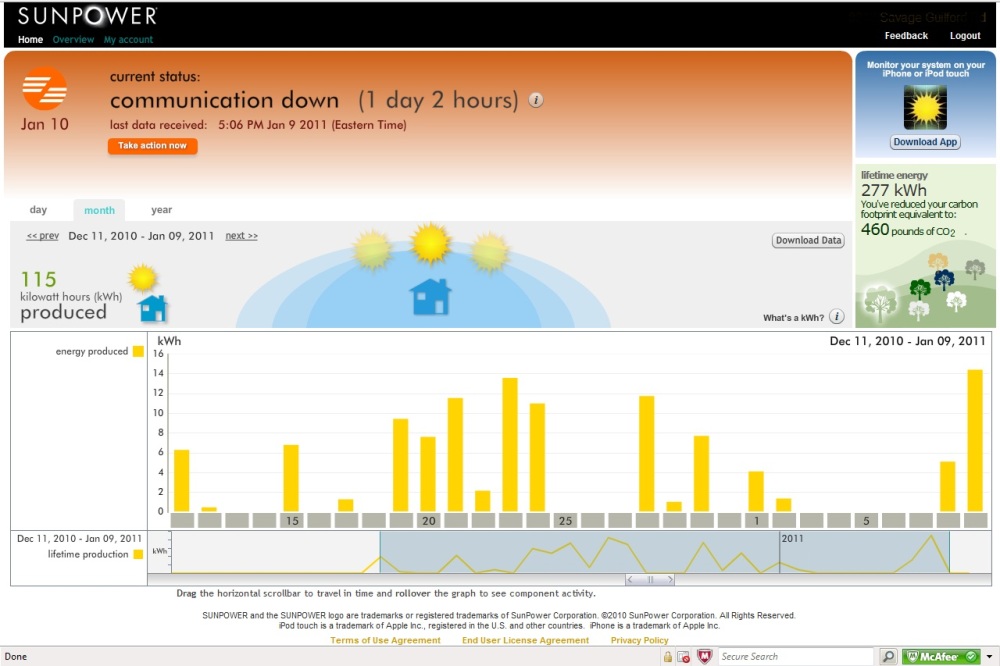
On March 29, 2011, Eric Mooney told me that my account was set up for SREC Trade. On July 8, 2011, I finally received my Maryland Solar Energy Grant money.  |

|
In the spring of 2013, I decided to get a solar thermal water heater. This was put on my house, not my garage. Since I don't believe in getting new solar panels put on a 20+ year old roof, I got a new roof. The solar thermal panels went on the south side. I decided to get more photovoltaic panels on the west side. My goal was to be net zero or as close to that as possible.
For the additional photovoltaic panels, I interviewed many of the same companies I considered for my solar thermal hot water heater since these companies did both types of installation. But in the end, Solar Energy World got my business again. So on May 21, 2013, I signed a contract to get ten Suniva Optimus OPT260-60-4-1B0 260 watt monocrystalline solar photovoltaic panels for a total cost of $10,140. This includes installation and central inverters. Originally, I thought we would go with microinverters since the west side of the roof on my house gets partial sunlight blockage from trees late in the day. But Brent felt that central inverters would be better since we were still going with only one roof surface. That is, if the panels were spread out between the west and the south sides of my roof, then microinverters would be a better choice. Additionally, for these particular panels, the central inverter would also be better because the Enphase microinverter has a 215 watt maximum capacity which means we would be "clipping" power. For this case, the central inverter ensures optimal output. These panels face west by southwest, having an azimuth of 248 degrees. The roof has a slope of 27 degrees. Annual output should be 3,131 kwh/year. This factors in the fact that we have 89% solar access on the west roof, where they will be installed. This is nowhere as good as our south roof which has 100% or darn near close to that amount. This much energy generation means we should save money in the following ways: This being the case, the system should pay for itself somewhere between ($10,140 - $3,042)/($350 + $351.58) = 10.12 years and ($10,140 - $3042)/$350 = 20.28 years, depending on how well SRECs maintain their value. Brent expects I will get back more on SRECs and avoided electric costs so he is estimating the system will pay for itself in 7.2 years. Regardless, it is much harder to justify the purchase of photovoltaic solar panels without the Howard County tax credit that was in place when I purchased my first set of panels. On June 3, 2013, James Carpenter came by to do a solar site assessment. Later that month, Jason Chretien sent me a proposed layout for the panels. It wasn't at all what I wanted. The original drawing that Brent provided would have all 10 shifted as far as possible to the south side on the west roof of the house. This would allow Norma and me to grow a tree on the north half of the west side of the house without having to worry about shade from the tree getting in the way of the panels. The drawing I received on June 20, showed the panels much further to the north side than what was discussed. Jason revised the drawing but said that in order to get the panels further south, they would need to remove one of our roof ventilation pipes and attic fan. That was unacceptable. After some discussion, we came up with the configuration shown below. 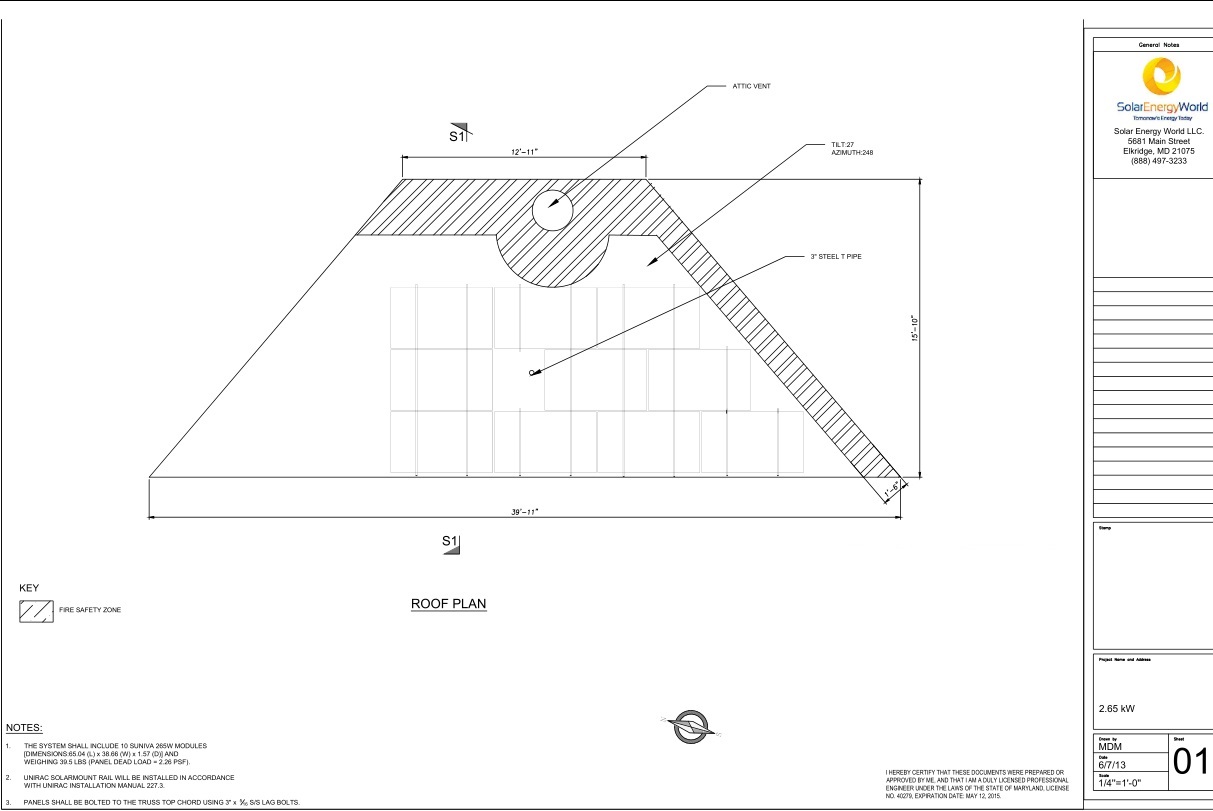
The amount of sunlight at each position is illustrated in the following layout. 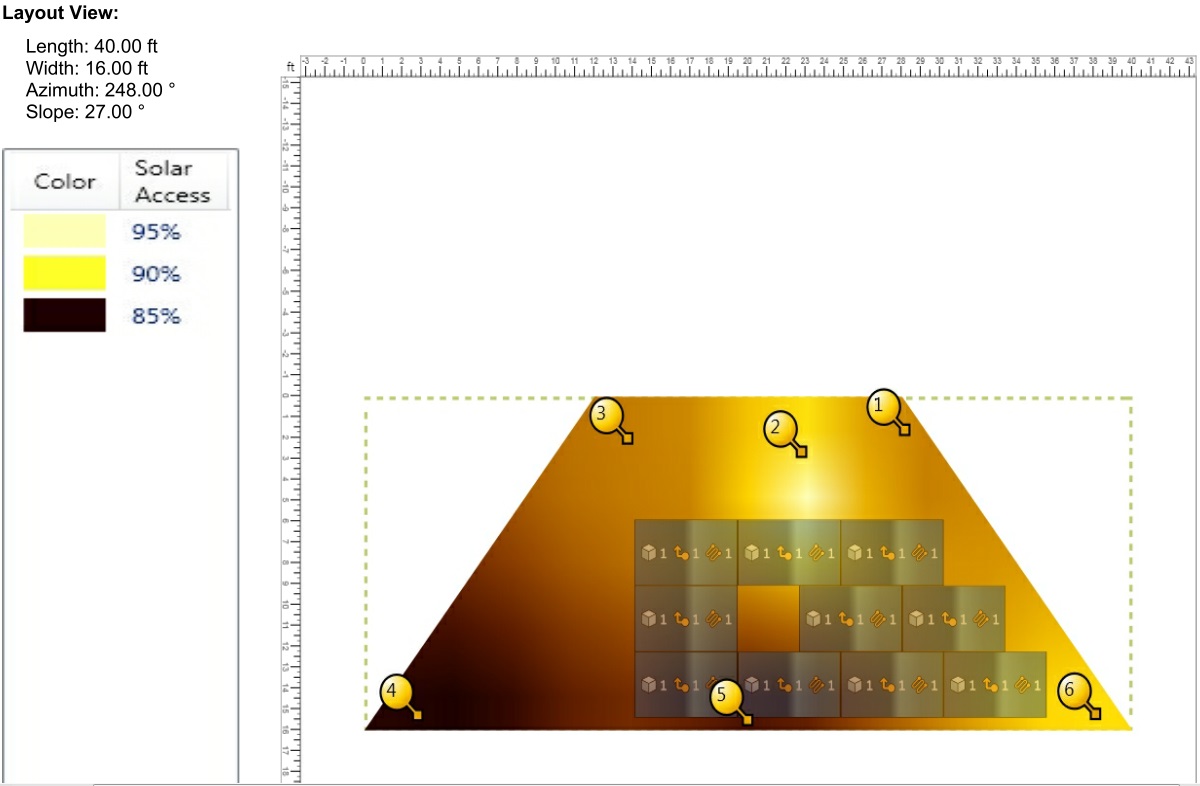
The expected electricity generation broken down by month is shown below. This turned out to be a little less than I expected (3,062.7 kWh instead of 3,131 kWh) though only by 2%. 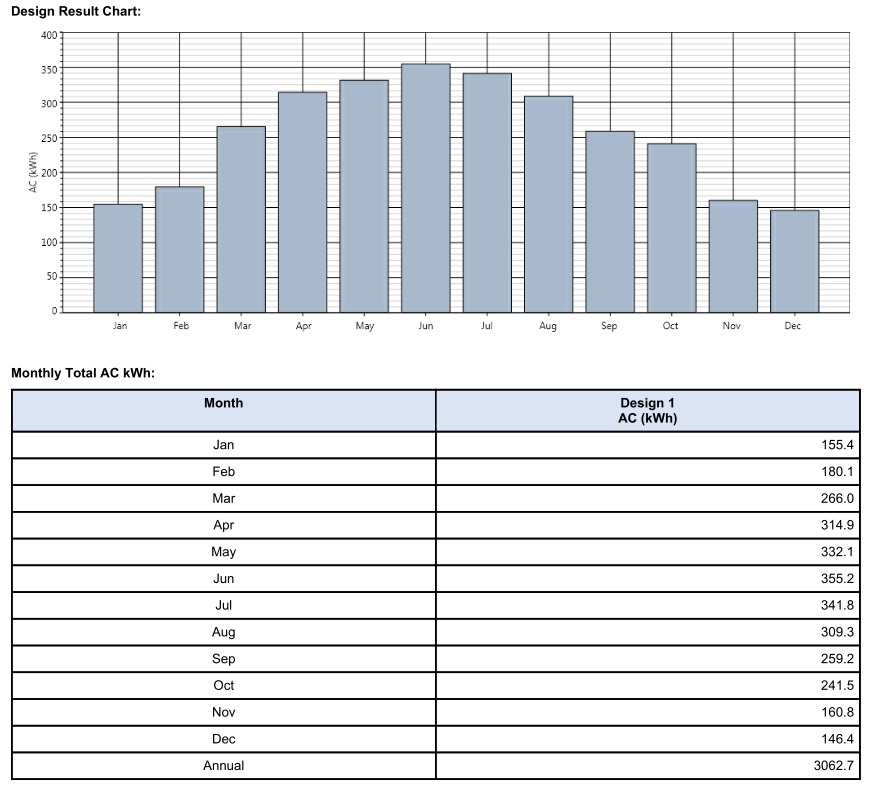
The actual installation was done in half a day on July 19, 2013. A fellow by the name of Mark was in charge. He installed what they gave him which was ten Suniva 265 panels with the silver edges. I was expecting the all black panels but the silver edges were fine and hardly visible except except from much much further back in my yard. The silver edge panels actually have better output than the 260s that I was expecting so it all worked out fine in the end. See the photo at the top of the page. Mark's team also installed the Power One PVI-3.0-OUTD-S-US Aurora String Inverter 3000 Watt central inverter on the west side of my house at the south end. Just below the house inverter was the electrical disconnect and production meter. This was placed next to the disconnect for the panels on my garage. Such disconnects are required by law to be accessible outside the house so the utility company can shut off my system when they work on the power lines. This protects the utility workers. Inside the house, an electrical conduit was run from the panels to my attic. The conduit then ran across the attic before turning to the basement. In the basement, the wires in the conduit connected to my breaker panel. Next to the breaker panel was the solar monitoring box which contains hardware for measuring data output. This data is sent to my modem via a Netgear 85 Mbps wall-plugged ethernet adapter, model XET1001 outlet gateway device, and then sent to a web page where I could then monitor production. This was installed in 2013 to replace a SunPower wireless display SPR-PMR-WDISP, part number 109874 which proved unreliable. On August 8, 2013, Keith Roycroft of Solar Energy World came by to meet the county inspectors and turn on my system. So as of August 8, 2013 the solar photovoltaic panels on my house are operational. I was set up with a web page where I could view the amount of energy my system generated. According to the screenshot below, my 2.65 kW Suniva system produced 15.52 kWh of electricity as of the close of August 9, 2013. Just for that day, it produced 7.66 kWh. This compares with 13.3 kWh produced on the same day by my SunPower system on the garage. I have 16 panels on the garage that comprise a 3.68 kW system. All things being equal, I would expect 13.3 x (2.65/3.68) = 9.57 kWh of electricity. But of course, all things are not equal. The panels on the house face west and do not get nearly as much sunlight as the panels on the garage. As I mentioned earlier, the garage panels have 100% solar access or near that. Panels on the house have 89% access. So I should be getting 9.57 x 0.89 = 8.52 kWh of electricity. The difference, 8.52 - 7.66 = 0.86 kWh, is about 0.86/8.52 = 10% less than the expected amount. My new Suniva panels should generate (2.65/3.68) x 0.89 = 64% of the amount of electricity as the older SunPower panels on my garage. 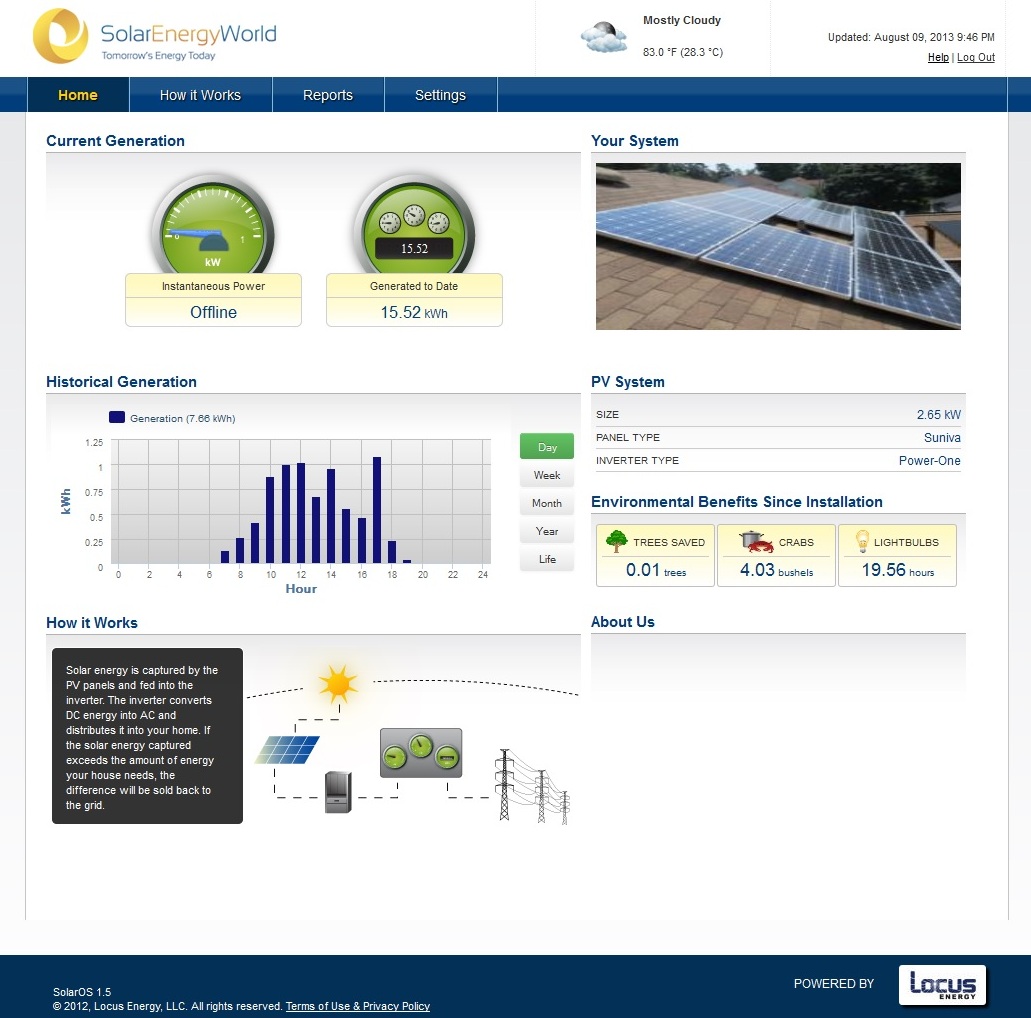
On August 13, 2013, I filled out and submitted forms so my SRECs from the new system will be managed by Sol Systems. I observed over a few days that my Suniva panels' energy gathering drops off sharply around 1800. I'm guessing that is when the sun drops behind the trees on the west side of my house. Over 13 days from August 10 to August 23, 2013, my new Suniva panels generated 131.59 kWh, averaging 10.12 kWh per day. In comparison, my older SunPower panels generated 210 kWh over this same period. This means my Suniva panels produced 131.59/210 = 62.66% as much genergy as the SunPower panels. This is easily within ballpark range of my expectation, which is 64%.  |

|
On August 29, 2013, I received word from the Maryland Energy Administration that my application for the $1000 energy grant was denied because I already have photovoltaic panels that I received grant money for two years ago.
...although the systems are on separate buildings and use different inverters, they still both deliver electricity to your home, is that correct? If so, this would count as serving the same load, and would therefore not be eligible for another grant. If this second system serves an entirely different load, however, then it may still be eligible. I wasn't upset about the state denying my grant application. I didn't think it was eligible in the first place. What annoyed me is that Solar Energy World thought I could get the money, knowing that I received it in 2011. In fact, they built it into their return on investment calculation. Had I known this, I don't know if I would have gone ahead with the purchase. I was later informed by Brent that as of 2013, the Maryland Energy Administration policy regarding the solar energy grant changed and his company was not fully informed of this change by the state. I have never known Brent to be dishonest. In fact, there are two times I can think of when he turned down the opportunity to make more money off me because he felt it was in my best interest. So I give him and his company the benefit of doubt.  |

|
Notice the nice Gaussian curve? This is the histogram on my SunPower account monitoring page for solar energy generation on February 15, 2011. While the amount of sunlight will vary throughout the year, days without variable cloud cover should yield a histogram with this "bell curve" shape.
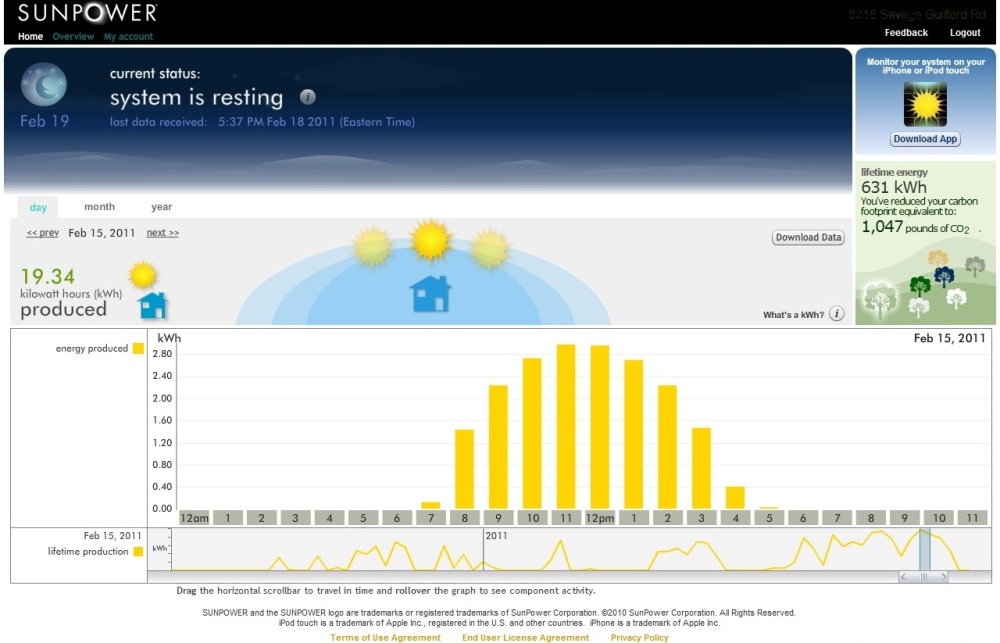
 |

|
One question I get is what happens if I generate more electricity than I consume? Now that I have 26 panels, this is a common scenario.
If the energy generated by the customer-generator exceeds the energy supplied by the utility during the month, the customer-generator shall be required to pay only the customer charges for that billing month, as required by the Rate Schedule under which the customer-generator is receiving service. The utility will carry forward a negative kilowatt-hour reading for a period not to exceed 12 months and that ends annually with the April bill. The utility will pay each eligible customer-generator for the dollar value of any accrued net excess generation remaining at the end of the previous 12 month period ending with the billing cycle that is complete immediately prior to the end of April. - from BGE - Common Questions and forwarded to me by Andre M. Unfortunately, this website no longer exists. As of 2015, I have not been able to carry forward a negative kilowatt-hour reading in April but my co-worker, Rod A. has. He was reimbursed 11.29 cents per kilowatt-hour. It wasn't as much as he pays for kilowatt-hour but it isn't significantly less either. I was told that it doesn't make sense, financially, to purchase more solar panels than you need, even if you can make some money off the electric company.  |

|
2010 - Gathering a baseline

My 16 SunPower 230 watt photovoltaic solar panels installed on December 7, 2010 should produce up to 3.68 kilowatts and an estimated 4,774 kilowatt hours (kWh) per year. This means they should produce an average of 13.08 kWh per day. 2011

2012

My 10 Suniva 260 watt photovoltaic solar panels installed on August 8, 2013 should produce up to 2.65 kilowatts and an estimated 3,131 kilowatt hours (kWh) per year. This means they should produce an average of 8.58 kWh per day. 2013

2014

2015

2016

2017

2018

2019

2020

2021

At the end of 2021, I decided I would stop documenting the amount of electricity my panels generated. Things were stable and I felt I had more than enough data to work with.  |

|
I would love to say that my experience with the photovoltaic solar panels was just a matter of getting them turned on and then never having to deal with them. Unfortunately, that has not been the case. Sometimes it takes awhile for technology to mature and for problems to get identified and later resolved. I expect that people getting solar panels now will have significantly less problems than I did.
My SunPower web page provided me with electric generation reports. So did my SunPower Wireless Display SPR-PMR-WDISP. But they did not agree. The discrepancy was significant. Geoff M. of Solar Energy World told me that the wireless display is not accurate and has been discontinued due to its unreliability. Danny P. mentioned the following: Typically when the monitoring drops out, your system is still producing power [but] you just can't see it on the website. You can verify this by looking at the SunPower inverter mounted on your garage. If you have a solid green light during the day you are not losing any production. Keep in mind the inverters are not considered revenue grade meters. The data they are displaying is +/- 5%. The solar meter we installed is the only device that is considered to be revenue grade which is +/- 2%. The meter is the most accurate measuring device in the entire system. I've had much greater success with the Suniva panels, which are on the house. Normally, these generate about 65% as much electricity as the SunPower panels on the garage. This relationship helps let me know if one of them is having problems. It is sort of like having two beehives. On August 27, 2014, Norma and I returned from our vacation. I checked the output from the solar panels and found that the SunPower panels were failing to show energy generation on days that they should. It started on August 12 where the dashboard only showed 0.74 kwh generation. Then on August 13-16, it showed no generation. 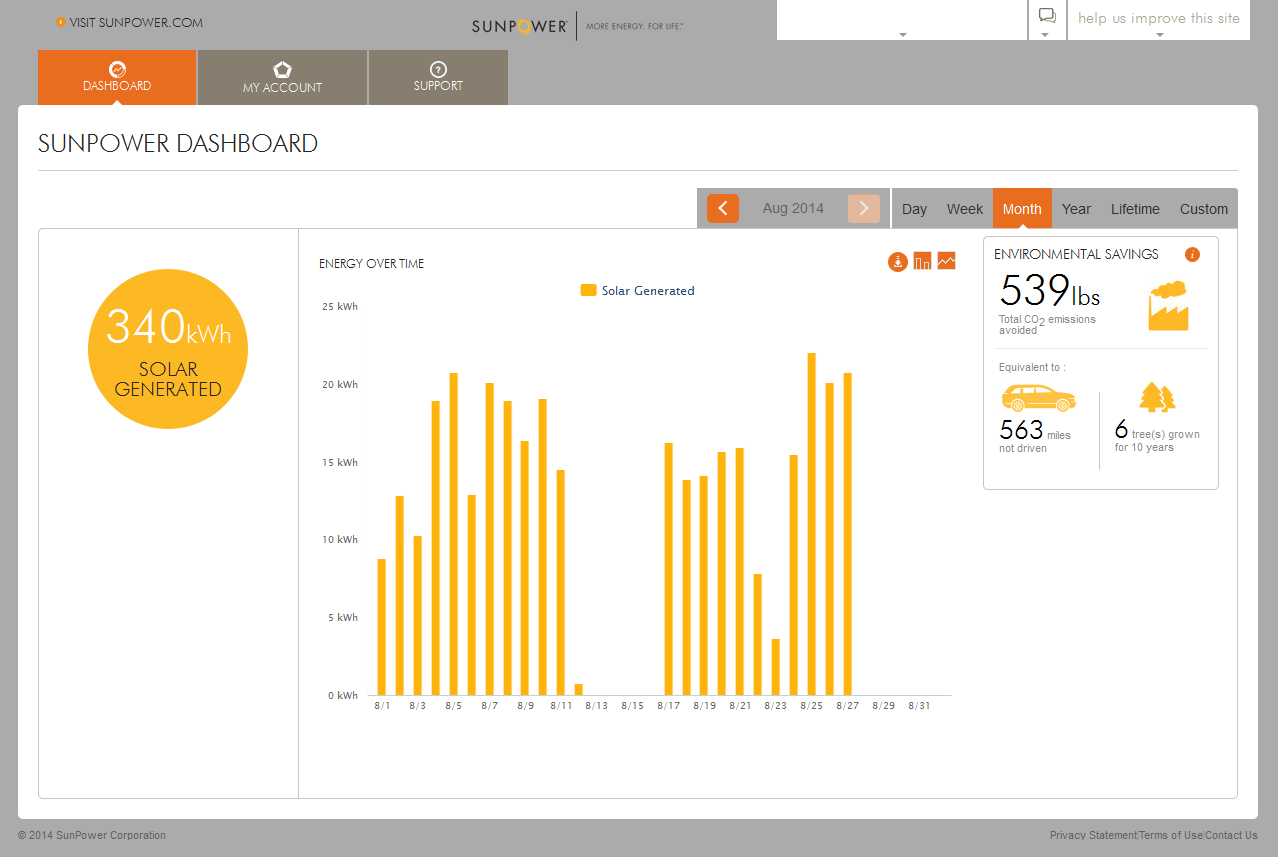
In contrast, the Suniva panels generated 51.32 kwh over the same period. 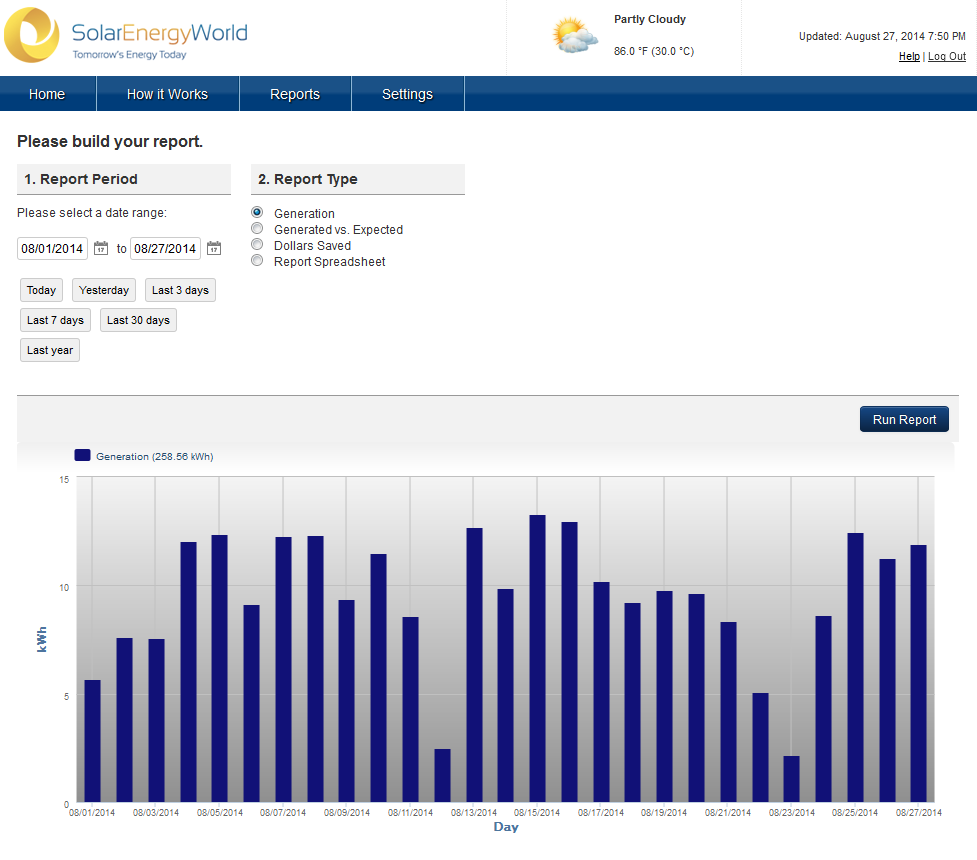
This means the SunPower panels should have produced about 78 kwh. The next day, I called Abby at SunPower, 1-800-786-7693. She had a note from Jeff Thomas of Solar Energy World describing my problem and SunPower had started tracking my system on August 6. She consulted with an engineer and assured me that the problem is with monitoring and not with the system producing electricity. She said that the system could have been reset and I should call again if I have the same problem. They will note it in their records. I explained that SolSystems uses this SunPower website to determine how many SRECs I've earned. She was not familiar with SolSystems so I told her it is an SREC brokerage firm. They need to accurately measure how much electricity my solar panels generate in order to ensure I get the SRECs I deserve. If the SunPower site does not reflect this, then I am not getting my fair share of SRECs. On September 1, 2014, I sent her this information along with a link to the SolSystems website by sending an email to customersupport@sunpower.com and including "Attn: Abby" in the subject. She did NOT get back to me. Very disappointing. On September 25 and 26, 2014, I found that my SunPower dashboard failed to record the day's energy production. There was sun, yet it recorded zero electricity generation. 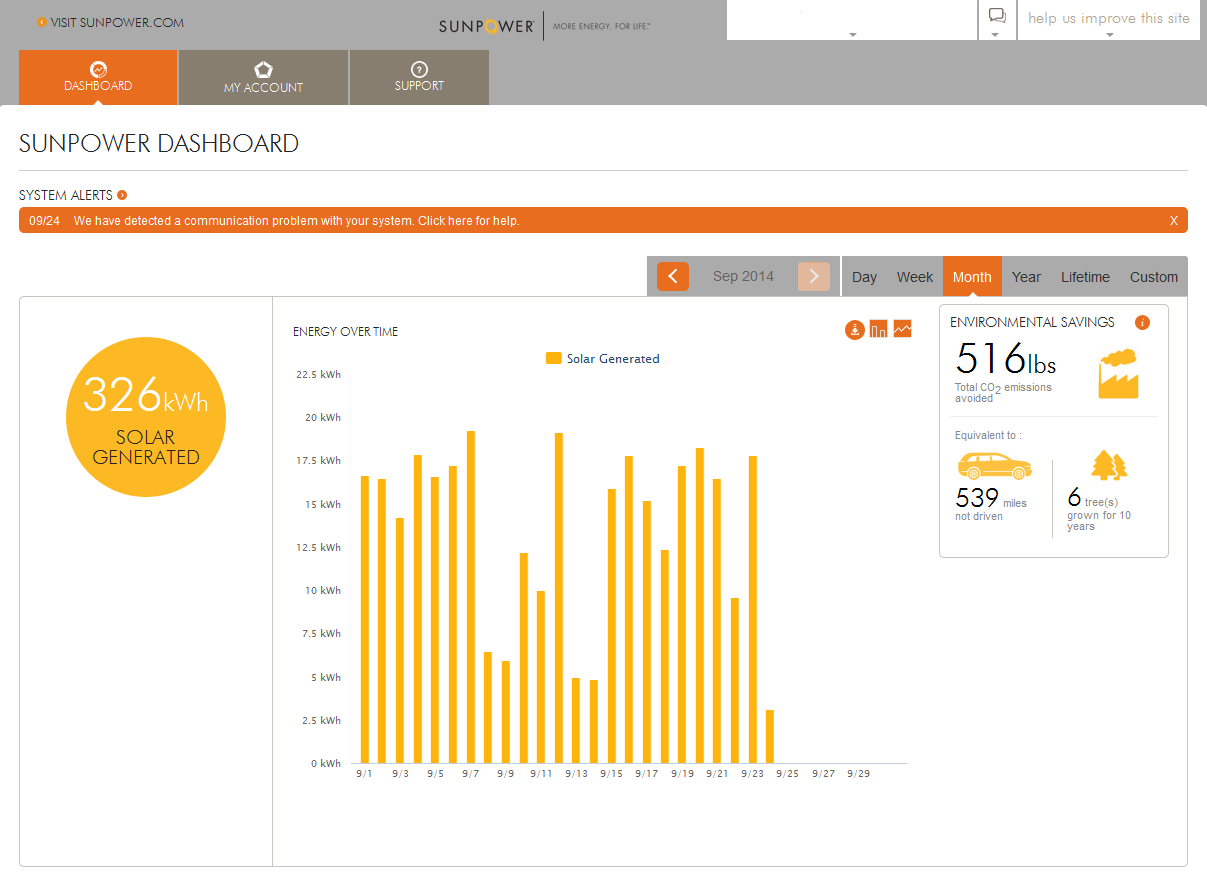
In contrast, my Suniva panels generated 3.92 and 3.01 kWh on the 25th and 26th, respectively. This means my SunPower panels should have produced about 6.125 and 4.703 kWh on these days, respectively. Note that in the above image, the dashboard reports that the problem started on September 24 with the message We have detected a communication problem with your system. Click here for help. I clicked it and got the message TROUBLESHOOTING: LOST CONNECTION Lease system customers, please call: 1-800-SUNPOWER. Non-leased system owners, please contact your Dealer. Dealer Name : Solar Energy World I checked my SunPower inverter which records the number of kWh generated by these panels and it did indeed verify that even though the dashboard did not report energy generation, power was being generated. In August/September 2015, I had to approximate how much energy my SunPower panels produced because there were issues with the SunPower website. I informed them of the problem on September 20, 2015. It is possible the problem was with the transmitter because no report was produced for August 14 to September 8. But when I went back a month prior and tried to review data that I know existed a month ago, all I got was a message that said "Waiting for Data" (see image below). An hour later, it said the same thing. Thus, my approximation is based on the proportion of energy the SunPower panels produced relative to the Suniva panels for the latest reading. 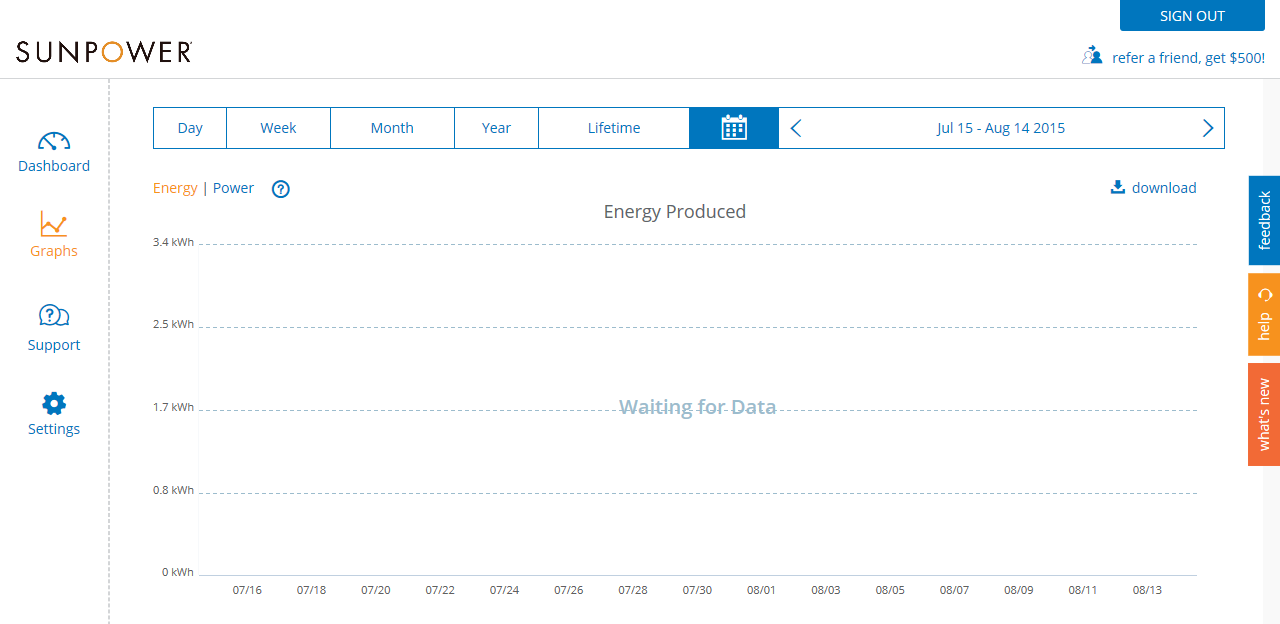
On October 24, 2015, I reported the SunPower website issues to Christine P. She replied back to me with the following: The data logger device doesn't have the capability to save the data if it has been reset or if it was down and therefore cannot be retrieved. On September 25, 2015, Christine P. sent me an e-mail to inform me that the problem with their website, which I reported on September 20, was fixed. It turns out my panels on the garage actually generated 567 kWh of electricity from August 14, 2015 to September 15, 2015. My earlier estimate was 558 kWh so I was off by 9 kWh 1.6%. On July 12, 2021, the Suniva panels quit registering electric production. The inverter reported an error message that read Error! Int.Error E031 Someone from Solar Energy World came out to look at it on July 28. He determined that the inverter is faulty. It is still under warranty and it will take 10-12 business days for a replacement to arrive. At that time, they will call me to schedule a time to come out and do their work. As of August 20, 2021, I haven't heard back from Solar Energy World regarding the faulty inverter. I called them and received a call back from Stephanie . She called PowerOne, the manufacturer, who told her there is a worldwide shortage on parts and replacements. Currently there is a four week turnaround but they cannot guarantee a date. Everything has been approved and they are just waiting for the part to come in. Eventually, this got resolved. I've had lots of problems with SunPower equipment but this was perhaps the first time I had any issues with Suniva. Problems can occur with any piece of equipment. That's why it is so important to choose a product and an installer that will be around for awhile. I can't imagine what I would have done if either had gone out of business and left me hanging.  |

|
In this section, I evaluate performance during the first year of solar photovoltaic use, December 8, 2010 to December 7, 2011: Actually, energy was generated on December 7, 2010 but for only half a day so I'm starting at the first full day of energy generation.
Taking this into consideration, had we not had solar panels, the cost of electricity alone purchased for 2011 would have been $438.91 + $256.86 = $695.77 while our total electric bill (with fees) would have been $695.77 + $180.08 = $875.85. With solar panels, our electric bill for 2011 was $256.86 + $180.08 = $436.94. If you add to this our annual heating cost of $867.10 (based on oil heat cutting and monitoring costs), then our annual energy cost in 2011 was $867.10 + $436.94 = $1,304.04. Without solar panels, it would have been $867.10 + $875.85 = $1,742.95. How does this compare to what Solar Energy World predicted? They expected the panels would provide 48% of our electricity so we're actually doing significantly better. They also claimed we'd save $568 per year based on our 2009/2010 energy consumption. They were off by only 2%! Overall, we are quite pleased with the results. I did not sell any SRECs in 2011 but had I sold the four I generated (one for each megawatt hour) at the November 2011 clearing priced of $210, I would have made $840. The amount of electricity generated by my solar panels in one year had a signficant effect on the environment by offsetting the amount produced by conventional means. How can one compare generating 4,776 kWh of solar energy?  |

|
According to a BGE Home folder I received, the annual energy bill for an average home is about $2,200. So even without the help of solar energy, our energy costs are about 1,742.95/2,200 = 79% of average. But is it really?
According to the National Association of Home Builders, the average home size in the United States was 2,700 square feet in 2009, up from 1,400 square feet in 1970. - from U.S. Home Size - Infoplease.com Our house has a finished square footage of 1,240. This means it is 1,240/2,700 = 46% the size of the average American home. But our pre-solar energy costs are not 46% the amount that the average American pays (I assume a linear relationship). With the help of solar, our energy costs are only 1,304.04/2,200 = 59% of what the average American pays. So where are we weak? In the BGE Home folder, non-heating costs account for 71% while heating costs account for 29%. Pre-solar, our non-heating costs account for 875.85/1742.95 = 50% while our heating costs account for 867.10/1742.95 = 50%. With the help of solar, our non-heating costs account for 436.94/1304.04 = 34% while our heating costs account for 867.10/1304.04 = 66%. Clearly, we are paying too much to heat our house. But in reality, these numbers don't tell the whole truth since heating and water heating are broken down into two different categories with water heating accounting for 14% of the average energy cost for a home. Our water heater is electric but it is supported by the oil heater in the winter. How much of it is supported by oil is something I do not know. But what I do know is that our heating costs are more than what they should be. Clearly there is room for improvement. On November 15, 2012, this improvement took place with the installation of a geothermal heat pump.  |

|
On December 20, 2010, a technician from BGE came out and replaced my electric meter with a new one. This new net meter runs backwards as well as forward. Hence, if my panels generate more energy than we use (as one might expect on a sunny day when we're not home), excess electricity will be fed back into the grid and our net meter will run backwards.
On August 16, 2013, I received a new net meter. I'm not sure why the last one wasn't sufficient but maybe this new one is also a smart meter that the utility company uses to gather more information about usage. Anyway, that afternoon, I noticed that the reading was 99,991, meaning that I produced 9 kwh more than I used. On August 16, 2014, our net meter read 880 kwh at the end of the day. This is exactly one year after it was installed. If I was electrically net zero, then it would have read zero or negative. Clearly I am far from this and have lots of room to improve. I blame the excessively cold winter, the fact that the geothermal heat pump was not working properly for much of the winter, and the energy used by the chickens' heat lamp (220 watts for 24 hours a day, 7 days a week, for about 5 weeks = ~185 kwh). Also, we still use some incandescent bulbs that we're waiting to have burn out so we can replace with energy-efficient LED. Yes, those are my excuses and I'm sticking to them. But the truth of the matter is that even without those obstacles, I really don't think we would have been net zero.  |

|
Perhaps the biggest questions are, "How much money have solar photovoltaic panels saved me" and "When will these panels pay for themselves?" I spent a lot of time gathering data to answer these questions.
2011

2012

2013

2014

2015

2016

2017

2018

2019

2020

2021

Conclusion

 |

|
One thing I did in 2011 to save money was change electric providers. Despite having solar panels, we still need to buy electricity. So why pay more for it when I don't have to? After the utility companies were deregulated, customers had a choice. By default, we have BGE, who, as of January 2011, charges 10.029 cents per kWh. But there are other choices available at
In 2011, I found Dominion to be the most competitive electric provider at 8.87 cents per kWh. On September 20, 2012, I made the necessary phone calls and filled out paperwork to switch my energy provider from Dominion Energy to Castlebridge Energy Group. This reduced our electricity rate from 8.87 cents per kilowatt hour to 7.79. Of course Dominion had an introductory offer they wanted to extend to me but it wasn't as low as that of Castlebridge. I also switched my tenant's gas provider from BGE to Castlebridge, thereby reducing their rate from 56.63 cents per therm to 51. Overall, this means a 12% savings in electricity and a 10% savings in gas. This considers only electricity and gas, not fees or taxes. In late January 2014, I switch my electric supplier from Castlebridge to Constellation. This was a two year contract that locked my electric rates in for 8.59 cents per kilowatt hour. This was much higher than our previous rate with Castlebridge which was 7.79 center per kilowatt hour but we also got a $50 gift card. Considering how little electricity we pay for, we clearly came out ahead on this one. My tenants got 8.49 cents per kilowatt hour and 58.9 cents per therm. So not as good of a rate for them but certainly better than what the competition was offering. I did some switching which I failed to document but the process is similar: The whole "switching providers" process is easy and transparent as long as you pay attention to the terms of your agreement. On March 14, 2017, I switched energy providers at both my Savage and Hanover homes. I called Clearview Energy, who had been providing electricity over the last several months at a rate of $0.0849/kWh. I asked them to cancel my service at both homes until the new provider took over. Next I called Shipley Energy, who had been providing gas at the townhouse over the last several months at a variable rate, with the latest being $0.5613/therm. I also asked them to cancel my service until the new provider took over. I then signed an 18 month fixed rate contract with Direct Energy. This contract is called "Live Brighter 18." It gives me electricity at $0.0769/kWh. This means a savings of about 9.4%. This is for both houses. I also signed a 24 month fixed rate contract with Constellation. It gives me gas at the townhouse for $0.519/therm. This means a savings of about 7.5% if compared to the last month's rate. On August 22, 2018, I switched my electrical energy provider back to Constellation. I reduced my rate and got a $100 gift card. Another thing that helped me save money was making use of RetailMeNot - Energy Coupon Codes. The best energy provider won't always be the same. I look for a long contract, a fixed rate, and gift cards. The choices were overwhelming but at the time, I was able to narrow my search significantly by limiting things to Direct Energy, Constellation, ClearView, Plymouth Rock, Shipley, Spark, WGL, and TownSquare. In 2021, my contract with Constellation ended and I ended up paying Constellation without a contract. My electric cost per kWh went from 33% from $0.0729 to $0.0969. After checking the competition, I went with the Spark Energy 12 month fixed plan which was $0.074 per kWh. Here are the runners up: Tomorrow Energy Corp, Major Energy, and Direct Energy Services. National Gas & Electric looked good at first but they have a monthly base fee. This might be fine if you use a lot of electricity but I don't think it would be worth it for us. The price for Standard Offer Service (SOS) through BGE is $0.0833 per kWh, effective through May 31, 2022. That is 12.5% higher than the Spark Energy 12 month fixed plan rate. I made a huge mistake regarding the previous paragraph. Constellation did an automatic renewal of my contract. There was a grace period but I let it slip by. By switching to Spark Energy, I got hit with a $150 early cancellation fee. I reviewed my contract and indeed, I was at fault. Pay attention to the grace period! That was a hard lesson to learn.  |

|
In 2011, I familiarized myself with Peak Rewards, a program offered by BGE to reduce stress on the power grid when demand is greatest. You may qualify depending if you have electric heating/cooling and/or electric water heating. There are other factors too, such as the size of your system. I've never had a problem with this.
 |

|
One thing that was not considered by Solar Energy World was the increase in the resale value of my property. According to Econ 101: Solar panels increase home values (a broken link as of 2023), photovoltaic solar panels increase home values by 3.5% in California. But keep in mind that this study was done using data in California...and not just any part of California but San Diego and Sacramento, which are known for being extremely sunny. Conversely, according to a now broken link from 2011 called Do Solar Panels Increase Home Value? real estate agents in the less sunny San Francisco area have a different opinion.
"My experience has been that [solar panels] do not add value...the sales price on two [homes with solar] I sold did not increase in spite of heavy marketing about the panels," said David Bergman, Silicon Valley real estate agent with Intero Real Estate Services. How would Maryland compare? My guess is that when it comes to solar panels, we have more in common with San Francisco than Sacramento or San Diego. In September 2013, I read in the "2013 Maryland Tour of Solar and Green Homes" booklet that Experts estimate that the value of a property with a photovoltaic system is increased by 20 times the yearly electricity savings. Unfortunately, this was a blanket statement...not one that was specific to a particular region. But if we assume that it is correct, my home will have increased in value 20 * ($556 + $350) = $18,120 as a result of the photovoltaic solar panels. This accounts for the 16 panels on my garage installed in 2010 and the 10 panels installed on my house in 2013. I tend to feel that the aesthetic value of your home may change depending on the location of your panels. I don't particularly find solar panels attractive. But ours are not very noticeable so I don't feel that is an issue. But for some places, it could make it more difficult to sell a home.  |

|
It was great showing my parents my solar panels during their December 16-21, 2010 visit. Unfortunately, my panels were covered with snow for the first few days. I noticed that my neighbors' panels had no snow on them while mine were still halfway covered. I attribute this to their roof being angled much more steeply than mine.
In 2014, our winter was the coldest I can ever remember. When we get snow, it tends to stick around meaning that my solar panels aren't earning their keep. If we had a steeper roof, the snow wouldn't stick around so long. The slope of our house roof that supports the Suniva panels is 27 degrees and the solar access is 89%. For the garage, which supports the SunPower panels, the slope is 17 degrees and the solar access is 98%. There is a pretty obvious difference in how much snow remains when comparing the two. My neighbor across the street has a roof with a slope of 45 degrees and solar access of about 92%. Their Mage panels have no snow when my Sunivas have about 40% snow coverage and my SunPowers have about 95% snow coverage. Like my SunPowers, my neighbor's roof faces south (an azimuth of 170 degrees). All these pics were taken around the same time on February 14, 2014. So just what is the ideal slope for solar panels? That all depends on where you live. According to "Optimum Tilt of Solar Panels" (now a broken link), If your solar panels will have a fixed tilt angle, and you want to get the most energy over the whole year, then this section is for you. A fixed angle is convenient, but note that there are some disadvantages. As mentioned above, you'll get less power than if you adjusted the angle. Also, if you live where there is snow, adjusting the panels to a steeper angle in winter makes it more likely that they will shed snow. A panel covered in snow produces little or no power. Use one of these formulas to find the best angle from the horizontal at which the panel should be tilted: Baltimore has a latitude of 39.2833 north. So the ideal slope for solar panels in the Baltimore area is (39.2833 x 0.76) + 3.1 = 32.9553 degrees.  |

|
Our cost for electricity in 2014 was $0.0859 per kWh. This was a variable cost since it was based on the number of kWh we consumed. There were also taxes or fees which were variable. These total $0.03634 per kWh bringing the total variable cost to $0.12224 per kWh.
There was also a fixed fee of $7.86 that is not dependent on how much energy we use. Even if we use no energy, we still have to pay the fixed fee every month. This is a delivery charge. If you use gas, then there is a separate delivery charge for that. Gas is a cheap heating source when you use it but the problem is that if you only use it for heating your house and you have a public gas line, then you are paying for the delivery charge year round, even if you only use it in the winter. My advice is if you have a public gas line, then use gas for as much stuff as you can: cooking, heating water, and drying your clothes. Otherwise, consider obtaining your own tank and having it refilled. So how much of our bill goes to pay for these "other" costs, meaning the bill that isn't just for electricity (or gas, if we had it)? This can vary throughout the year. You just need to closely examine your energy bill to find out. If you have solar photovoltaic panels or generate your own electricity via other means to reduce your utility cost, then variable costs are good because they are a function of how much electricity we use. If solar offsets our electric usage, then our usage could be zero, meaning that our variable costs would also be zero. In contrast, fixed costs are bad if you generate your own electricity because even if you don't use any electricity, you're still paying the fixed cost. Where my parents live, in California, they have much higher fixed costs in their utility bill so there isn't as much incentive for them to have solar photovoltaic panels.  |

|
The summer of 2018 was the darkest summer in Savage, ever!!! Maybe not "ever" but at least since 2011...and I have the data to prove it.
In 2010, 16 SunPower photovoltaic solar panels were installed on the south-facing roof of my garage. Then in 2013, I had 10 Suniva photovoltaic solar panels installed on the west-facing roof my house. That same year, I had an AET/Vaughn thermal solar panel installed on the south-facing roof of my house to heat water. Here's the data provided by my SunPower interface. Listed below are the number of kilowatts of electricity generated by my SunPower panels from June 21 to September 22 for each year below. Clearly, my SunPower panels have generated the least amount of electricity in the summer of 2018. I didn't bother to list the Suniva data but I expect it to support this observation. It typically generates 60-65% as much electricity as my SunPower panels. Fortunately, my geothermal heating and cooling system isn't affected by all the cloud cover and rain we've been having. The screenshot below shows the amount of electricity generated by my SunPower photovoltaic panels since it became operational on November 30, 2010. 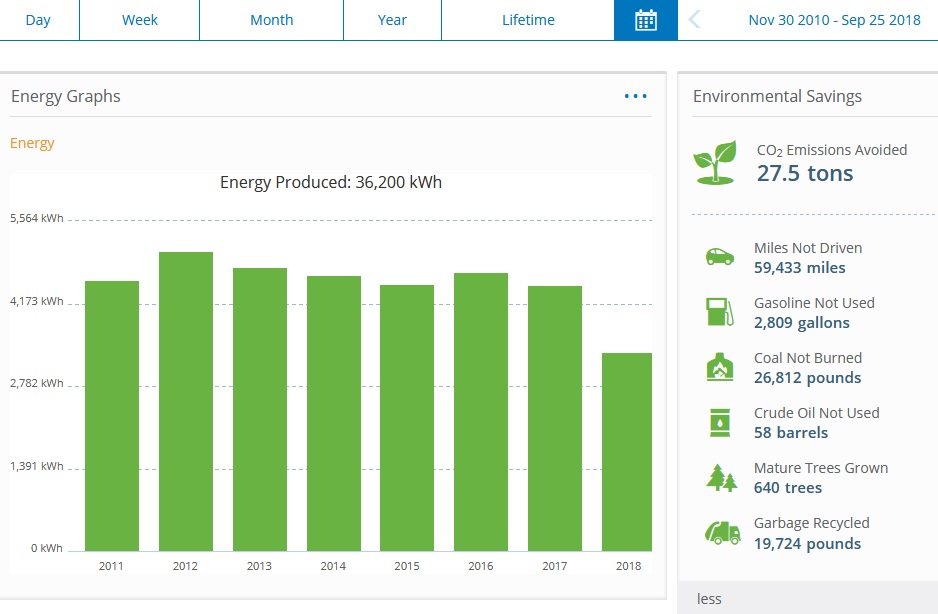
By far, 2018 was Baltimore's wettest year on record. Baltimore's weather record book goes back to 1871. - from "The Baltimore Sun - 2018 was Baltimore's wettest year on record" Solar photovoltaic panels aren't just a means to generate electricity, they are also an objective means of collecting certain types of weather data.  |

|
Sunny days are obviously good for solar photovoltaic panels to generate electricity. All things being equal, how does heat come into play? Are sunny hot days better than sunny cool days? The answer is no.
There are a lot of electrical components in a solar photovoltaic system and anyone that works around computers will tell you that heat makes them not function as efficiently as cold. I do not have any information to quantify this. Note that this statement applies to solar photovoltaic and not solar thermal systems.  |

|
On October 6, 2013, our house was recognized as one of 48 on the "4th Annual Maryland Tour of Solar and Green Homes." This means it was listed in a booklet and open to the public for the afternoon. What makes our home green? We use solar photovoltaic panels, solar thermal hot water heater, geothermal heat pump, rain barrels, extra insulation in the attic, composting, and a pellet stove which burns fuel made from sawdust and other wood waste. All this in a home built in 1952! The event was a success. I had about 25 attendees, mostly neighbors, co-workers, and kayakers, and there was never any down time. It lasted from 1100 to 1800.
 |

|
I have considered getting photovoltaic panels for my rental townhouse, which I purchased new on January 22, 2007. But the problem (as of 2011) is that rental properties are not eligible for the 30% federal tax credit. But I am eligible for a tax refund since it is a business expense. But this means that for a $32,292 system, instead of getting back $9,688 as a federal tax credit, I would only get $6,458 (20%).
One issue with townhomes is that the ratio of roof space to living space is small. So if you have a lot of space to heat, cool, and live, then you'll find your solar panel real estate quite limited. Regardless of how many panels you get, you still need an inverter and infrastructure. So to maximize your bang for the buck, it makes sense to get a lot of panels...enough to make your home as close to net zero as possible. This will be challenging for a house with a relatively small roof. I ended up selling my townhouse on June 30, 2021.  |

|
In January 2014, I learned that some people are having problems with squirrels chewing through the wires that connect to their solar panels.
Fortunately, this has not been a problem for me or anyone that I know.  |